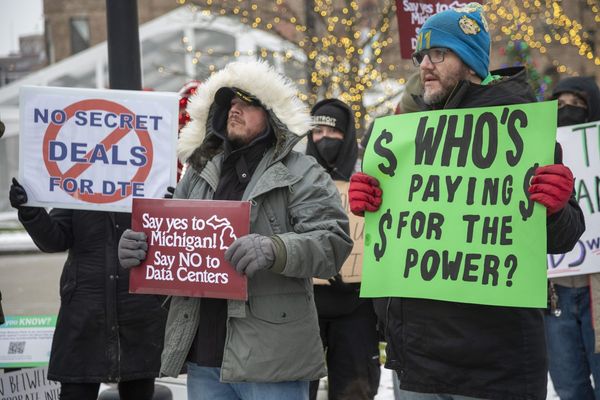House Republican leaders are barreling ahead with a vote early next week on their all-in-one budget framework designed to knock out a huge swath of President Donald Trump’s legislative priorities in one filibuster-proof basket.
But they head into the vote on the fiscal 2025 budget resolution, currently expected Tuesday, on shaky ground, with resistance from various factions that make it difficult to see how they can adopt the reconciliation blueprint. They can lose just one GOP vote, assuming no Democrats support it and all members vote.
The current strategy on House Republican leaders’ part appears to be to sell it as a mere procedural vote, simply to unlock the ability to ram through a partisan package over Democrats’ objections. Plus, Trump wants it.
But Trump himself continues to send mixed messages. After the Senate adopted its competing budget plan early Friday morning, which would carve out defense, border and energy policies for quick action but leave tax cuts for later, Trump said he was open to it.
“It gives you optionality,” Trump said on Fox News’ Brian Kilmeade radio show, adopting language used by Senate Majority Leader John Thune earlier in the week. “We want one big, beautiful bill, as I say, and you know that would include many other things … but to have what we approved yesterday is nice, and we’ll see now how the House is going to do.”
That’s a less direct tone than Trump struck earlier in the week, when he gave his explicit endorsement to the House’s approach — at least the second time since being inaugurated that the president has offered hope to the Senate GOP’s two-track plan. That undermines a bit of House GOP leaders’ sales strategy with wavering rank-and-file members, including several centrists who are strong supporters of the president.
Still, those who are bullish on House Republican leaders’ chances say Trump’s endorsement, education efforts conducted by Speaker Mike Johnson, Majority Leader Steve Scalise and Majority Whip Tom Emmer, as well as the process argument should pay dividends.
Medicaid
Sources familiar with the conversations said discussions around Medicaid will be key to the whip effort. There will likely have to be some cuts to the joint federal-state health insurance program for the poor to make the numbers add up in a way that would keep GOP spending hawks on board.
While Trump seemed to take Medicaid cuts off the table earlier this week, he also stressed that “fraud” in the program should be rooted out. Making the case about curbing waste, fraud and abuse in Medicaid, limiting benefits to only the most vulnerable and cutting back on aid to adults without disabilities in a program that has seen massive growth is a winning argument with moderates, one source familiar with the whip effort said.
Still, with the Energy and Commerce Committee instructed to find a total of $880 billion in 10-year savings — and likely more, in order to meet the budget’s target of $2 trillion in overall cuts — within its jurisdiction, some substantial amount of Medicaid cuts is likely. Opponents of deeper cuts, including hospitals and state and local governments, have their work cut out for them.
The National Conference of State Legislatures, U.S. Conference of Mayors and other government groups wrote to GOP leaders in both chambers on Friday urging them to avoid any proposals that would force states and localities to shoulder more of their health care costs.
In particular, they cite proposals like per capita caps on state grants and eliminating the 90 percent federal matching rate for states that expanded Medicaid to more adults under the 2010 health care law. The latter policy could cut nearly $600 billion over a decade; the former, $900 billion.
Work requirements for adults without disabilities may have more support within the GOP conference; a version was included in Republicans’ debt limit package that narrowly passed the House in 2023. That proposal was scored at only $109 billion in savings at the time, but GOP lawmakers with higher proportions of Latino and lower-income constituents are pushing to limit the Medicaid cuts.
Perennially endangered GOP Rep. Don Bacon, representing Nebraska’s “blue dot” district surrounding Omaha, said in a statement that the current budget resolution appears to cut too deeply into Medicaid.
“I’ve asked the House leadership to prove to us that $880 billion in cuts to E&C won’t overly cut Medicaid. That is my request,” Bacon said Friday.
Nearly 14 percent of constituents in Bacon’s district, which backed former Vice President Kamala Harris over Trump in November, are Medicaid beneficiaries, according to census data compiled by the Georgetown University Center for Children and Families.
Process
GOP leaders have also repeatedly stressed that the House blueprint is just the key they need to unlock the ability to use reconciliation: Basically, give us the chance to write that filibuster-proof legislation and we’ll work with you on whatever you need to vote for it.
Johnson has been making this point for weeks, including during his conference’s retreat at Trump’s Doral golf club near Miami on Jan. 29.
“What we’ve emphasized to our colleagues here is, remember the resolution is just the first step in a long process,” he said at the time. “And so the real battle is not … in the budget resolution, it’s in the final package. So everybody here still maintains their voting card, and they have the right to stop this process.”
That argument has been successful with some members from the New York delegation, for instance, who are holding out for some kind of relief from the $10,000 cap on state and local tax deductions as well as softer spending cuts.
But it hasn’t solved all of their Northeastern problems, including with Rep. Nicole Malliotakis, R-N.Y., who is still on the fence. She signed this week’s letter to leadership along with other members of the GOP Hispanic Conference opposed to deep cuts in Medicaid, food stamps and Pell Grants.
Part of the process argument is that now that the Senate has acted, members uncomfortable with the deep cuts being proposed in the House can have a chance to shape the framework more to their liking in conference.
Johnson “can tell House moderates that the only way to bring the more moderate Senate bill into the negotiations is to pass the House bill and get it to conference,” said Jessica Riedl, a former top GOP budget and economic aide who is now with the conservative Manhattan Institute.
Hard-liners
But GOP leaders still start out with seemingly diametrically opposed factions within their conference. Even after the deal bringing the House Freedom Caucus on board, which got the resolution through the Budget Committee last week, other hard-line members like Republican Reps. Tim Burchett of Tennessee, Victoria Spartz of Indiana and Thomas Massie of Kentucky will be tough nuts to crack.
For example, Burchett last week said he wants “severe cuts” — upward of $2.5 trillion — as part of the reconciliation package and he has never voted for a debt limit increase. The House budget would allow for a $4 trillion debt limit increase, enough to get past next year’s midterms.
Burchett is “leaning no, but undecided,” a spokesman said Friday.
Spartz has said she opposes the debt limit increase and that the cuts target is too small.
“Current version of the budget resolution was a good step forward but still needs some work to stop some serious fraud, waste and abuse through Congress, especially in healthcare,” Spartz wrote this week on X, formerly Twitter.
She’s currently a “no,” a Spartz spokesman said Friday.
Caitlin Reilly, David Lerman and Sandhya Raman contributed to this report.
The post House Republicans ready to roll the dice on budget blueprint appeared first on Roll Call.







